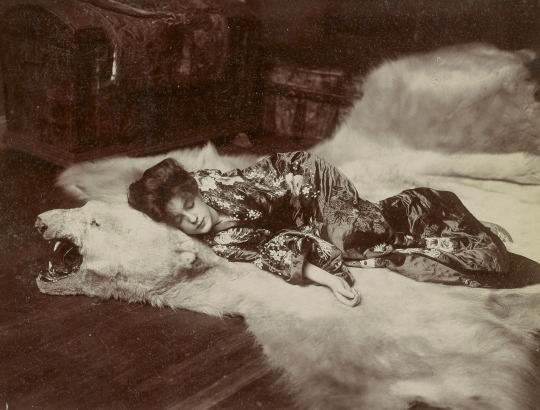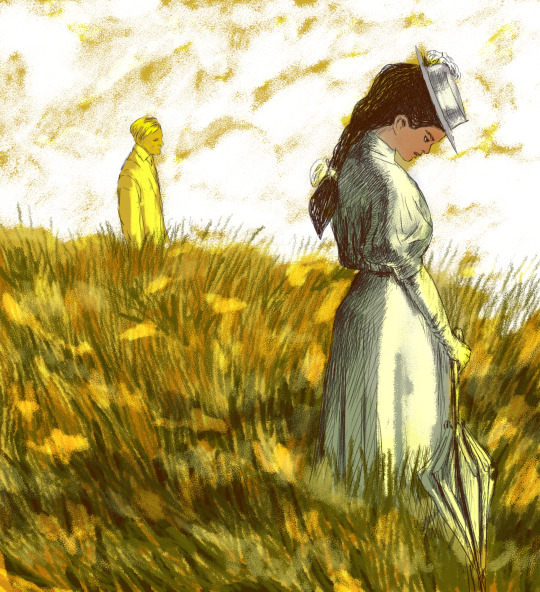Text
Una, throughout Rainbow Valley:




Walter, throughout Rainbow Valley




23 notes
·
View notes
Text
An Unfortunate Lily Maid




Anne of Green Gables, Chapter 28, Lucy Maud Montgomery
Illustrations by Abigail Halpin.
30 notes
·
View notes
Text
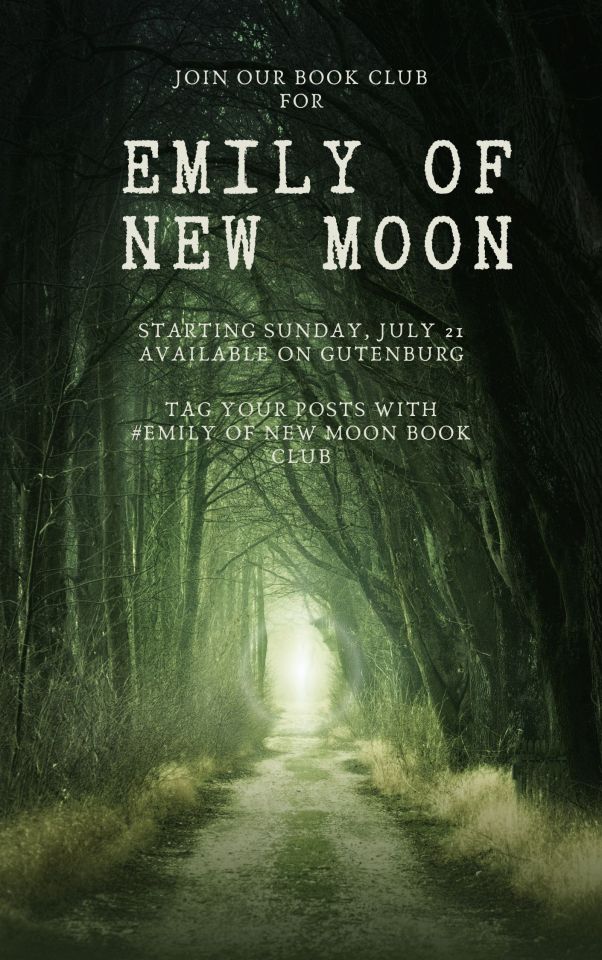
Book can be found for free online here! We'll do a chapter a day again. Also, I'm sorry world, but the chances of me posting the link again everyday are very slim lmao
70 notes
·
View notes
Text
A fascinating read, and new stories/authors to discover! Thank you so much for typing and sharing it @gogandmagog !! 🧡
Guys! Yesterday I had a book-shaped piece of mail, and inside of it was my copy of Children and Childhoods in L.M. Montgomery: Continuing Conversations being returned, from another very dear user here! I bring this up only because some-months-ago I promised to copy out a particular article from this book, for yet another user here, who was interested! Interested because it’s on the the subject of a Fan Favourite thing... fan fiction. And better still because some of our (basically famous) mutuals here are mentioned by name! If you’ve ever wondered if the Montgomery scholarship is reading your fan fiction... the answer is yes, they are! They totally are. More than that, they also have some thoughts to share… as well as recommendations of their faves too! This article even covers the F/F and M/M fan fiction presented by fans in LMM’s universe, and I’m personally super excited to be able to begin reading these works, as soon as I can find them all. I’ve done my best to link what I could immediately find, but some of the mentioned stories were unavailable... potentially due to changes in usernames? (That said... if anyone knows of the works indicated here, that I haven’t provided a link for, please do share!)
This article, by the way, was written recently... in 2020! It’s very current, and it covers a few stories that were still being actively updated during the pandemic. The focus of this article is less so on canon (or really just the Anne/Gilbert pairing), though, and seems to prefer demonstrating the versatility of mixing relationships (Anne and Emily, for one!) and the wider more general universe-building aspects (the entanglements of future generations/Anne’s grandchildren) that fans have been expounding on for nothing less than decades.
Okay, here we go! xx
Continuing Stories: L.M. Montgomery and Fanfiction in the Digital Era by Balaka Basu
Fanfiction – the recreational (re)writing of texts – is a literary genre of rapidly growing significance. Abigail Derecho in her brief history of fanfiction identifies it as “a genre that has a long history of appealing to women and minorities, minorities, individuals on the cultural margins who used archontic writing as a means to express not only their narrative creativity, but their criticisms of social and political inequities as well.”
Insightfully defined by Francesca Coppa and Mary Ellen Curtin as “speculative fiction about character,” fanfiction can be even more precisely understood as fantasies about the diegetic positioning of characters in the context of various settings, communities, relationships both textual and paratextual, and eventually all manner of cultural mythologies.
Kristina Busse and Karen Hellekson describe the production of fanfiction as “part collaboration and part response to not only the source text, but also the cultural context within and outside the fannish community in which it is produced.”
They point out that the shift in the method of dissemination of fanfiction from newsletters and zines to internet archives means that “ever-younger fans who previously would not have had access to the fannish culture except through their parents can now enter the fan space effortlessly; financial resources have become less of a concern because access to a computer is the only prerequisite; and national boundaries and time zones have ceased to limit fannish interaction.”
The nature of fanfiction allows participants to cross-generational and socio-economic boundaries in an ongoing exchange of responses to a source text with which they share a fascination, developing new texts that in turn elicit their own responses. While the creation of fanfiction is evidence of an affective, loving, communal relationship with the source text, this genre of writing is still dismissed in many quarters as overly emotional, purely erotic, and even perverse, a type of amateur and immature engagement with popular texts that produces writing necessarily divorced from literary significance. Produced in staggeringly vast quantities by subcultures with complex vocabularies and traditions that can intimidate the casual reader, fanfiction is perceived by many to be more of a cultural practice than a literary genre, variously denigrated for its pornographic potential and its lack of originality. However, close examination reveals that fan writers are able to create a critical dialogue with the originating author in acts of communal storytelling that incorporate allusions and reference points to which other dedicated fan readers and writers may respond.
In this chapter, after examining how L.M. Montgomery and her writer heroine Emily themselves engage in practices now associated with fanfiction, I survey four forms of fanfiction that remove Montgomery’s novels from her seemingly idyllic and timeless island settings, contextualizing her characters and plots within history and other genres: the sequel set during the Second World War, the modern AU (alternate universe), the gap-filler, and the slash fic, all of which allow the young readers who grow up with her novels to engage in dialogue with the stories they love, a type of literary conversation that Montgomery herself models within her texts. Emily’s reading, which is active rather than passive, resembles twenty-first-century fans’ ownership of the texts they love, provoking creative responses. For instance, after reading works by Lord Tennyson, Elizabeth Barrett Browning, and Matthew Arnold, Emily writes, “Teddy lent me 3 books of poetry. One of them was Tennyson and I have learned The Bugle Song off by heart so I will always have it. One was Mrs. Browning. She is lovely. I would like to meet her. I suppose I will when I die but that may be a long time away. The other was just one poem called Sohrab and Rustum. After I went to bed I cried over it. Aunt Elizabeth said ‘what are you sniffling about?’ I wasn’t sniffling – I was weeping sore … I couldn’t go to sleep until I had thought out a different end for it – a happy one.”
The reactions Emily catalogues are those of the fan; they are viscerally felt in the body and attempt to dissolve the boundary between author and reader, producer and consumer. She inscribes Tennyson within her heart in order to possess the poem she loves; she creates a relationship between Barrett Browning and herself; and, most significantly, she interjects her own desired happy ending into Arnold’s tragic narrative, a corrective desire that is at the core of many works of fanfiction. Emily’s diaries and her story reflect Montgomery’s own experiences from childhood to adulthood as reader, writer, and reader-turned-writer discussed in the introduction to this volume. Depicting Emily as a voracious reader and a life-writer like herself, Montgomery places the child Emily’s voice in conversation with that of the narrator through Emily’s letters to her dead father in Emily of New Moon and through her diary entries in Emily Climbs and Emily’s Quest, creating a form of joint authorship that is referenced explicitly in “Salad Days,” the second chapter of Emily Climbs: “book is not going to be wholly, or even mainly, made up of extracts from Emily’s diary; but, by way of linking up matters unimportant enough for a chapter in themselves, and yet necessary for a proper understanding of her personality and environment, I am going to include some more of them. Besides, when one has material ready to hand, why not use it?”
The narrator’s willingness to use the “material” that is “ready to hand” reflects Montgomery’s and Emily’s practices, and also validates other writers’ use of the material Montgomery places at their disposal. As with many fans, Emily’s reading frequently makes itself felt within her writing.
Like Montgomery, Emily learns her trade through mimicry, from her first poem in blank verse inspired by James Thomson’s Seasons to her unwitting imitation of Kipling that is pointed out by her teacher, Mr Carpenter, in his review of her work. Like Sara Stanley of The Story Girl, whose compelling and fascinating stories are rarely if ever original, Emily is a fan of the oral traditions of her community, incorporating and building upon them in her own writing, transforming and recreating, for instance, the story of “The Woman Who Spanked the King” in Emily Climbs.
The retelling and versioning that Emily practises signal her immense admiration for the source texts she adapts, just as the creation of fanfiction does for Montgomery’s readership and fans. The possibilities inherent in versioning and adaptation are illustrated in Emily’s Quest. When Montgomery depicts Emily undertaking the reworking of someone else’s narrative, she is adapting an episode from her own experience while working for The Echo in Halifax, which she records in her journal. Montgomery, like Emily, was asked to create an ending for a serialized story, “A Royal Betrothal,” after compositors had misplaced the original text.
Like Emily, she claims that her “knowledge of royal love affairs [was] limited,” and that she was unaccustomed “to write with flippant levity of kings and queens.” Nevertheless, Montgomery manages to create a conclusion that passes muster, since “as yet nobody has guessed where the ‘seam’ comes in.” She is, however, curious about the original author’s reaction to her unauthorized adaptation, and while she never discovers this in real life, she does imagine it in her fiction when she introduces Mark Greaves, who is horrified by Emily’s new ending for the story but enchanted by its author. Neither Montgomery nor Emily engages in this sort of writing from a place of fandom; they have no previous attachment to “A Royal Betrothal,” and both are writing professionally. Nevertheless, the ability to solve the puzzle of the story and the weaving of their work into an already extant text are the very project of fanfiction: ludic narrative composition that recalls the way children play make-believe with the narratives they love, reworking and extending them. It is telling that Montgomery uses the metaphor of the “seam” to describe this particular craft. Jane Dawkins, writing about her fanfiction, which is inspired by Jane Austen, describes her fan novel Letters from Pemberley as “an old-fashioned patchwork quilt, where in place of the scraps of fabric reminding one of the favorite frocks or shirts whence they came, there is a line or a phrase or a sentence from one of [the original] books or letters stitched alongside the lesser scraps of my own manufacture.”
Montgomery’s final book, framed by the two world wars, is just such a patchwork sequel, albeit providing only brief glimpses of the characters that readers met as children and who have now grown older. When a version of the book was published in 1974 as The Road to Yesterday, these glimpses, lacking the interstitial materials, became even briefer, mirroring the more forced insertion of beloved characters that the two earlier collections, Chronicles of Avonlea and Further Chronicles of Avonlea, display. Only two of Anne’s grandchildren – Gilbert Ford and Walter Blythe – are obliquely referred to, in the story “A Commonplace Woman,” where an unpleasant young doctor reflects on both of them as potential rivals for the affection of a beautiful girl he himself hopes to pursue.
However, the full novel, The Blythes Are Quoted, published in 2009 and comprised of short stories about the people in Glen St Mary and over the harbour, is interspersed with poetry by both a young Walter and an adult Anne. The poems are cut with tiny slices of dialogue that suggest the continuing lives of fans’ favourite characters and how they might have developed. In “‘Dragged at Anne’s Chariot Wheels’: L.M. Montgomery and the Sequels to Anne of Green Gables,” Carole Gerson notes the mixture of feelings from pleasure to frustration that Montgomery records in her journals as she prepares to write her first sequel.
While Montgomery wrote the first installments of her various series out of inspiration, she was certainly aware of what her market desired from subsequent installments. She often regretted the necessity of marrying off her characters, but was aware that her fans demanded this conventional outcome for the characters they had come to love; these traditionally romantic endings, when not offered by Montgomery herself at the instigation of her publishers, are regularly deployed by contemporary fanfiction authors building on the source texts.
Indeed, long before the original structure of The Blythes Are Quoted was revealed to readers in Benjamin Lefebvre’s afterword, fanfiction writers were spinning off lengthy narratives that included a third generation of young Blythes, Fords, and Merediths dealing with the onslaught of the Second World War. While earlier installments in the Anne series – such as Anne of Green Gables and Anne’s House of Dreams – depict the deaths of Matthew, Anne and Gilbert’s first daughter (Joyce), and Captain Jim, Walter’s death in Rilla of Ingleside is somehow more striking. Unlike Matthew and Captain Jim, he has not yet had time to grow old; unlike Joyce, readers have had opportunities to get to know him as a child in Rainbow Valley and as he grows into young adulthood in Rilla of Ingleside. His death is unnatural and, therefore, all the more horrifying. These two aspects of Rilla of Ingleside – the evocation of history by a nostalgic fictional world that is still tied to real time and the use of high drama, tragedy, and romance – provide fanfiction authors with a model they can use to appeal to the emotions of those readers who are immersed in the next generation of Montgomery characters.
The Second World War, then, provides an entry point into the series for fanfiction authors, who can deploy real history coupled with beloved characters to create a tale that feels absolutely authentic. One example of this is a short story, “The Pen and the Sword,” written in 2007 by MarnaNightingale. Here, mimicking the style of Dorothy L. Sayers’s The Wimsey Papers (a series of Spectator articles published between 1939 and 1940, which interestingly also continue the story of First World War–era characters during the Second World War), MarnaNightingale employs epistolary excerpts and newspaper articles to tell the story of a family going through the horrors of war for a second time. Grounding her fragmented story – like The Blythes Are Quoted, a mixture of genres – in the accounts of novelist Mollie Panter-Downes (1939) and war correspondents Ernie Pyle (1940) and Ross Munro of the Canadian Press (1941), whose articles are attributed to Kenneth Ford, she offers a story that, like Rilla of Ingleside, is anchored to the historical moment, while also nostalgically focusing on the character development that comes from Gilbert Ford’s death, Rilla’s and Faith’s reactions to the war, and the lives of their children. Here war also serves as an opportunity for new experiences, particularly for women and children: Rilla takes a factory job as a machinist, liking it better than working in Carter Flagg’s store; one of Anne’s grandchildren, Susan, plans to be a doctor; and Faith, who worked as a Voluntary Aid Detachment nurse in the First World War, mentions how she can sympathize. As well, the daily tidbits that flavour the pages of Rilla of Ingleside are there: one article, attributed to Anne, includes the recipe for Susan Baker’s war bread, reminding readers of the problems of wartime rationing, even in the Americas. Real life events – like the Canadian forces trying (and failing) to make a beachhead at Dieppe – arouse the passions of the reader. Unlike Austen – who also famously wrote of three or four families in a country town, but kept the Napoleonic wars firmly in the shadows – Montgomery brings the passions and high drama of the world stage into the sleepy villages of Prince Edward Island, which inspire fanfiction spinoffs.
The long novel Cecilia of Red Apple Farm, by a fan author who posts under the pseudonym ruby gillis, also directly reworks passages and scenes from the whole range of Anne books, set in the late-nineteenth century, to The Blythes Are Quoted, set in the early years of the Second World War, to highlight the similarity between her new generation of characters and their ancestors. Cecilia is the daughter of Una Meredith and Shirley Blythe (characters often married off in fanfiction). Like MarnaNightingale, ruby gillis provides period flavouring in the styles of dresses and behaviour and in references to 1940s popular films and songs. Simultaneously, this setting offers new opportunities to her female character: Cecilia wants to be a doctor, and rather than staying in Canada, she joins up to be a nurse in England. She has a series of romances – one with Sid Gardiner (before he marries May Binnie), and one with her cousin Blythe Meredith, who is this generation’s poet – before finally ending up with Marshall Douglas (the son of Mary Vance). Just as Anne initially refuses Gilbert Blythe in favour of Roy Gardner’s resemblance to her ideal man in Anne of the Island, ruby gillis’s Cecilia is fooled by the allure of Sid and Blythe as Roy Gardner–like romantic heroes into believing that she does not truly love her fun, practical, “Gilbert-esque” friend. Published in 2004, Cecilia of Red Apple Farm further illustrates the opportunities presented by reusing and reworking a body of texts through its incorporation of Montgomery’s poem “I Wish You” as the work of Blythe Meredith. Montgomery includes this poem and attributes it to Anne in The Blythes Are Quoted, although ruby gillis could not have known this when writing. The repetition of names and circumstances might seem derivative, but for readers who have read and reread the original books so many times, the extension of the story world is prized, even if – perhaps even because of – its callbacks to the original text. Due to the tendency of fans to fixate on “the good bits” in a reread, these parts can be taken for the whole.
Austen fanfiction demonstrates this aptly. Indeed, Helen Fielding’s second Bridget Jones novel, Bridget Jones and the Edge of Reason (1999), illustrates just such a reading of Pride and Prejudice: she shows Bridget, a fan, watching the scene from the 1995 mini-series in which Darcy, dripping in a wet see-through shirt, exits the lake, and then rewinding and rewatching the scene multiple times. How many times might a similar fan reread Walter’s letter from Courcelette? This repeated reviewing of selected portions can replace the amplitude of the original novel. With this delimited focus, narrative is no longer seen as a progression, but as a single moment of pleasure, sustained as long as possible. Reading the Second World War as a repetitive sequel to the First World War further highlights this possibility.
Even Montgomery seems to do so, as demonstrated in The Blythes Are Quoted, with its new generation of characters confusingly named after the old: Walter, Jem, Rilla, Di, Anne, and Gilbert. A variation on Marah Gubar’s kinship model, this kind of continuation highlights the blurred boundaries between child and adult characters who are literally related to one another and whose adventures mimic one another.
In a third example of fanfiction set during the Second World War, Weeping May Tarry, a long novel by ElouiseBates, Meggie, the heroine, is Shirley’s daughter (and also, surprisingly, Paul Irving’s granddaughter). In this story, which like Cecilia of Red Apple Farm is an installment of a longer series, Meggie is sent off to a conservatory of music to study singing, aptly combining the traditions of the nostalgic boarding-school novel with “Girl’s Own” wartime fiction. Following the tradition of Magic for Marigold, which explicitly suggests in its second chapter that the Murrays of Blair Water and the Lesleys of Cloud of Spruce exist in the same universe, @e-louise-bates (like many other fanfiction authors, including ruby gillis) suggests that all of Montgomery’s characters exist in a single universe: Meggie partners briefly with the grandson of Sara Stanley (The Story Girl and The Golden Road) and is close friends with Jane Stuart (Jane of Lantern Hill).
Going even further, @e-louise-bates introduces the grandchildren of the What Katy Did series as friends for Meggie and includes Betsy from Dorothy Canfield Fisher’s Understood Betsy as Bruce Meredith’s wife, creating a world where all the characters of early-twentieth-century girls’ fiction seem to have truly lived, where their descendants must cope with victory gardens and dances with soldiers at the Exhibition Grounds, and where kisses are much more commonplace than they once were.
These particular continuers of Montgomery are also desirous of membership in the community of her fans, seeing their literary endeavours as productive of approval from a fellow readership. Likewise, the novels are notable for their sociality – they seem to offer the reader not only a fantasy friendship with the characters themselves but also the very real society of fellow readers of the works. Thus, these fan authors attempt to diversify their stories so that they represent contemporary beliefs regarding multiculturalism; ruby gillis, for instance, introduces into the family by way of marriage a French girl who has had to flee the Nazis due to being Jewish, a situation Montgomery and her contemporaries might have had some difficulty accepting, considering early-twentieth-century attitudes toward interreligious marriage and Montgomery’s othering of the German-Jewish peddler who sells Anne green hair dye.
The Second World War thus offers writers of Montgomery fanfiction the loom on which to weave new, more diverse stories, even as The Blythes Are Quoted, which also traces the characters’ reactions to this new war, demonstrates how these readers-turned-writers followed Montgomery’s own trajectory, not knowing that they were doing so. On the subject of fanfiction, young-adult author Patricia C. Wrede writes: “The thing that fascinates me about fanfiction, though, is the way that it models the decision tree that writers go through (whether consciously or unconsciously) to get to their final product. For those of us who do this part mostly unconsciously, it can be interesting and instructing to see the multitude of alternate paths that a story could have taken, all laid out more-or-less neatly in different authors’ fanfics [… taking a slightly different fork in the road] resulting in the plot veering in a completely new direction. Friends become enemies; enemies become friends; goals and objectives and results shift and change.” Within these pieces of fanfiction, then, fan writers are able to follow these decision trees with subsequent generations of characters as well.
Another avenue of access occurs when fan authors transpose historical narratives into the contemporary moment. Perhaps the best-known example of this modern alternate universe [AU] conversion is the television program Sherlock, which takes Arthur Conan Doyle’s Victorian detective into the twenty-first century. While new cultural contexts appear, the essence of character is meant to be retained. Just as Sherlock uses text messages and blogs to substitute for telegraphs and handwritten journals, fans of Montgomery reimagine the relationships between her characters as if they were taking place online.
For instance, “Work in Progress” (2012) by verity postulates a friendship between Montgomery’s most famous heroines, Anne and Emily. In this piece of fanfiction, Emily circumvents Aunt Elizabeth’s injunction against fiction during her time at Shrewsbury High by becoming a blogger who is restricted to the “truth.” The story’s online summary, a part of which reads “Anne rolls her eyes. ‘Is your aunt really going to know if you cheat on your nonfiction with some hot prose on the side?’” shows how the story preserves the character qualities that Montgomery laid out, complete with references to the Murray pride and Anne’s orphanhood. Mr Carpenter’s admonitions are spelled out at the beginning of the story:
“Emily Byrd Starr has a sticky note on her desktop. It reads:
ITALICS
CAPITALS
!!!!!
“just”
“really”
CTRL+F!
It is almost like having Mr Carpenter in the room with her.”
Verity creates humour through the juxtaposition of contemporary social media and allusions to Montgomery’s source text. Another story by verity detailing Rilla’s romance with Ken Ford and her friendship with Una Meredith, “Rilla of Toronto,” takes place mainly through instant messages. In this story, Rilla reflects on her life from eighteen to twenty-five, tracing a continuum from her child self to her new adulthood, underscored by verity’s translation of Montgomery’s work into contemporary millennial language.
A third type of fanfiction narrative, the gap-filler, focuses on and expands the implications of the source texts. Moira Walley-Beckett’s Netflix/CBC series Anne with an “E,” as Laura Robinson shows in chapter 12 of this volume, is somewhat fanfictional in and of itself: as Robinson points out, the show fills gaps by bringing to the fore the darker currents that have always been beneath the seemingly untroubled waters of Anne of Green Gables, including Anne’s potential post-traumatic stress disorder from the disturbing life she led before coming to Green Gables. This kind of versioning and adaptation tacitly permits fan authors to feel that their versions are just as valid as those produced by professionals. Gap-fillers frequently expand on romantic pairings and in fandom are often referred to by portmanteaux of characters’ names that perpetuate some inside joke or work as puns. “Shirbert” – a moniker for Anne and Gilbert – is the latter, and demonstrates how fans posting on sites like Archive of Our Own (Ao3), Fanfiction.net, and Wattpad (this last generally populated by younger fans) develop their own language to identify their stories within the community for which they write.
One such story, “You caught me staring, but I caught you staring back,” by Anuka, clearly inspired more by the television series than the novels, begins with an author’s note that reads, “I decided to write some fluff for these two, because I need more Shirbert moments, and season 2 is so far away. I added gifs to make it more vivid.” Here, the romance between Anne and Gilbert as depicted by Montgomery and Walley-Beckett is not sufficient for the reader-turned-writer. Anuka wants the gaps in the narrative to be more fully explored than they are on either page or screen and to be made more “vivid” by the inclusion of images that help make the story come alive.
Similarly, “Rilla Blythe’s Wedding: A Not Entirely Comprehensive Account” by Scylla also fills a gap: Rilla and Ken’s wedding day, a scene that Montgomery leaves to the reader’s imagination at the end of Rilla of Ingleside. Modelled upon other accounts of weddings within Montgomery’s fiction, the story also suggests that accounts of Walter’s death have been gravely exaggerated, as he makes a stunning appearance at his sister’s wedding. In order to align her work with Montgomery’s novel, Scylla ensures that Little Dog Monday’s awareness of Walter’s death remains, but makes it only a technicality, writing, “His heart had stopped for a full ten seconds – long enough for his Captain to feel for his empty pulse and for Dog Monday to be jolted with the fullness of his death. Little dogs, after all, can only have tender dogs’ hearts. Grief to Dog Monday was an all-consuming thing, and when Walter’s heart began to beat once more, he was deaf to its spark of joy.” After meeting with his eldest sister, Joyce, in heaven – which is, as he had always hoped, Rainbow Valley, Walter is returned to life so that he may write of peace as well as war (as he did when he was a boy), marry Una, and repair the broken hearts of readers who did not want to lose him.
While heterosexual pairings are the most prevalent in Montgomery fandom, there is room for queer imaginings as well.
This very popular genre of fanfiction, known as “slash,” is generally defined as stories that centre on samesex romances between characters, particularly between men. Montgomery slash fiction usually stars Walter Blythe.
One slash story, “but i don’t know who you are” by @freyafrida, imagines a bisexual Walter. Told in an enduringly popular sub-genre of fanfiction often referred to as Five Things Plus One (which involves a series of thematically linked but not necessarily chronological scenes), the story is summarized by @freyafrida as “Five people Walter thought he wanted, and one person he didn’t notice until it was too late.”
This last person is original to Montgomery’s text: Una, whose apparently unreturned attraction to Walter is woven through Rilla of Ingleside. The other five potential partners are all alluded to as Walter’s close friends, beginning in childhood with Alice Parker from Anne of Ingleside and Pat Brewster from The Blythes Are Quoted and then carrying on through adolescence and young adulthood with Faith Meredith, Ken Ford, and finally Paul Irving from Anne of Avonlea. While his feelings for Faith and Ken are clearly unrequited, Alice, Pat, and Paul all express their own desire for Walter. The inclusion of the famous poet and Walter’s “model” uncle, Paul Irving, in particular, particular, illustrates how traits of sensitivity and aesthetic appreciation that challenge traditional ideas about masculinity are frequently interpreted as queer by fan readers and writers.
In another slash fiction, cero_ate’s “The Moving Finger Writes, and Having Writ Moves On,” Walter discovers his homosexuality while fighting in Europe:
He wrote half truths and lies once more, when he wrote his Rilla that he could not form poems of the depths of the war. For who could write his sister of the phallic love he had found? He had found his reason in a tow-headed American boy. He meant so much more to Walter than mere friendship could explain. He wanted to write, as sweethearts write, of the tempest of joy in the darkest night. But how would they understand? How would they even try to understand he sought not the Dark Lady of Shakespeare but the youth, fair and Wilde? When he was presented with Una’s faithful heart, he spurned it. When his tow-headed darling presented his own, Walter took it, greedy for him. His grecian style love, the boy who’s [sic] eyes danced, even in the darkest of days. He would do anything to keep him safe. But he could not present him to his family, for their scorn or pity. War had broken him, but made him as well.
While male/male pairings are generally the most popular stories in fandoms, Montgomery’s novels, peopled as they are by communities of girls and women, require that readers who want to queer the text must explore what is called femslash (that is, slash fiction featuring two female characters).
Such relationships have been explored within the academic setting. For instance, Laura Robinson remarks in “Bosom Friends: Lesbian Desire and the Anne Books,” that the relationship between Anne and Diana uses “the language that readers associate with adult romantic love rather than girlhood affections,” even as it is expressed through the heterosexual paradigm of marriage.
One fanfiction author, ArcticLava21, makes it clear that such fan written stories are not speculation but instead address key issues of representation. The author’s note to ArcticLava21’s short Anne/Diana story, “Nature,” reads, “Hello everybody! Hope your [sic] having a wonderful day. Before anyone yells at me for ‘sexualizing platonic friendships’ please note that this is for all those queer kids who grew up pretending. Pretending that he ended up with him instead of her, or desperately wanted representation. Are we good? <3 Enjoy yourselves lovely people.” The intended audience of the story, “queer kids who grew up,” again establishes the transgenerational kinship between Montgomery’s child and adult fans.
All fan fiction, shared on the Internet, exist in dialogue not just with Montgomery’s fiction but with the author herself, and between the fans who read the novels as children and adolescents and the adults that these readers become.
Whether fan writers extend the narrative or fill gaps, transpose chronology or to queer the text, these pieces of fanfiction allow fans not only to insert themselves into the narrative, but also simultaneously to revivify the original novels, published a century ago. In performing interventions to the text, Montgomery’s young fans grow up to reply to the discussions that she began long ago in the pages of her journals and stories, ensuring that all three – author, reader, and text – are continually reborn into a conversation that will never end.
49 notes
·
View notes
Text
“I had a hard time to get her, I can tell you that.”
— Gilbert Blythe, of wife Anne, to their son Jem, the Blythes are Quoted by Lucy Maud Montgomery
32 notes
·
View notes
Text
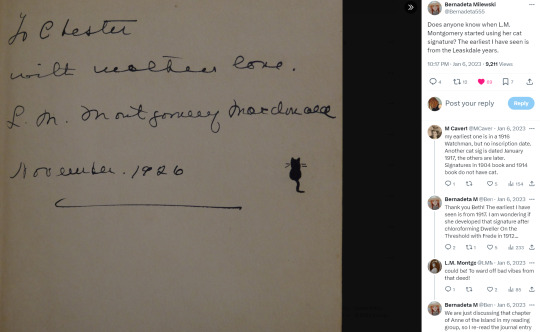
Saw this on X and thought about your post about the little cat doodle @gogandmagog
Looks like it was her "cat signature".

There’s a signed copy of The Watchman and Other Poems available on abebooks.com, and this one even comes with an extra little cat doodle that Maud drew. 🐈⬛
69 notes
·
View notes
Text
A Tintype of a House with Seven Children and a Large Dog
I love browsing this Flickr account that is full of antique pictures bought in flea markets etc.
They're mostly from America, but since they cover the late 19th/early 20th century, they sometimes remind me of the AOGG book series, especially this one.
Seven children?? (Let's pretend Joy Blythe lived). A dog! (Hello Dog Monday!)

If you look closer you can even see that there are 3 boys (Jem, Walter and Shirley), and 4 girls (Nan and Di, Rilla, and another little girl...) in the picture.
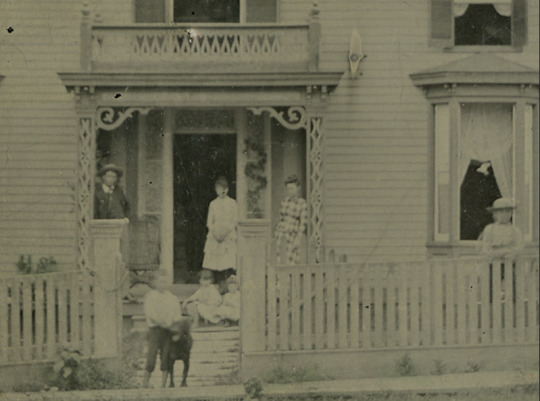
13 notes
·
View notes
Photo
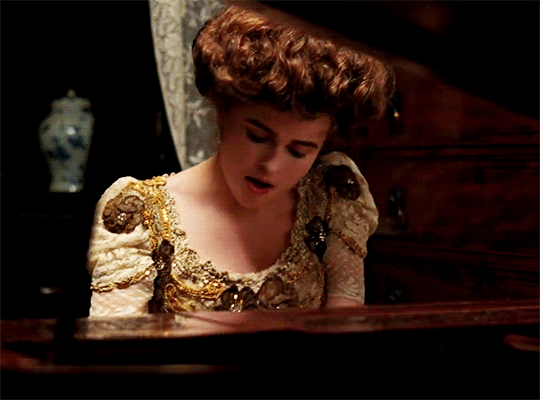


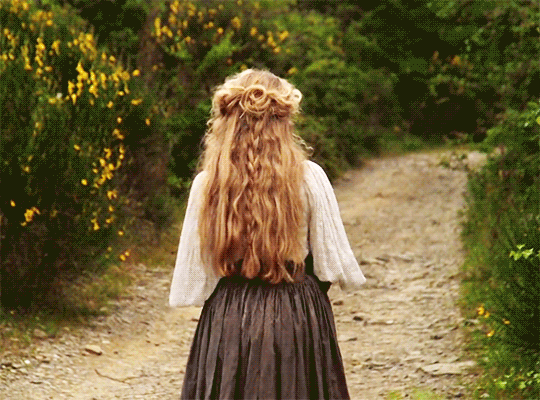
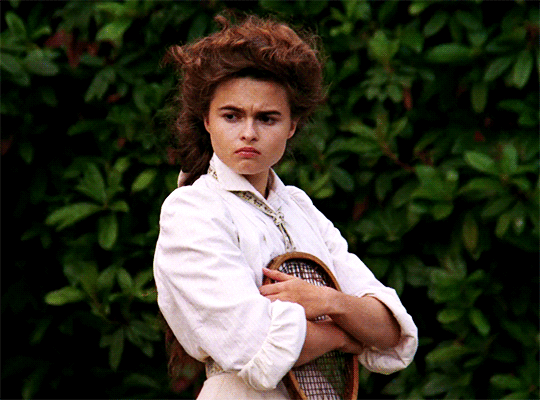
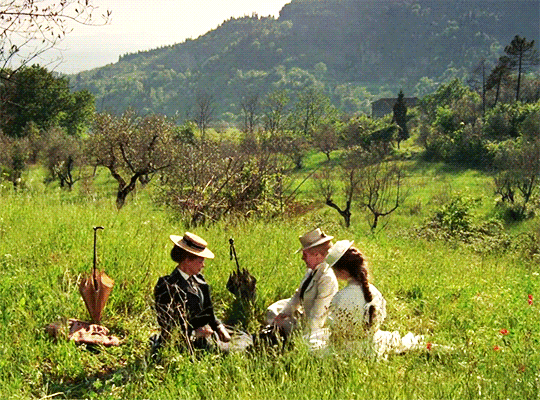
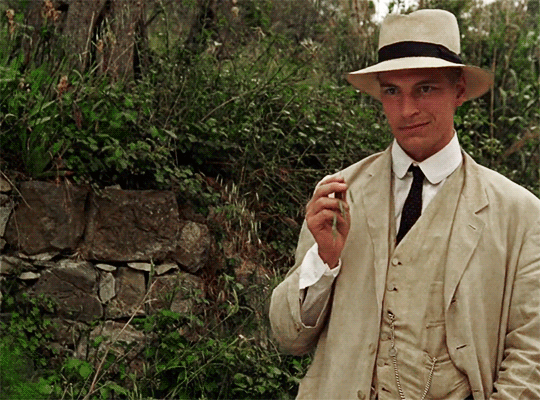

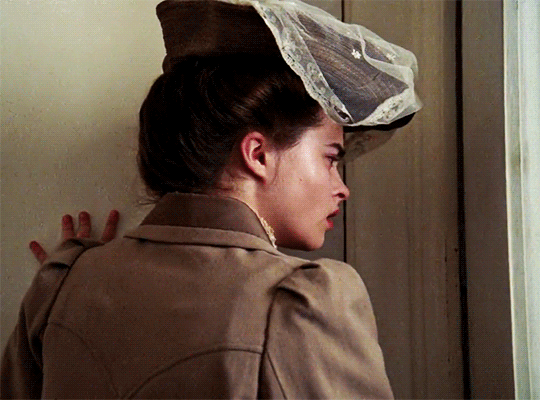
Period Drama Appreciation Week 2022
Day 4 ❥ Favorite Film
What is it about Italy that makes lady novelists reach such summits of absurdity?
A Room With A View (1985) dir. James Ivory
1K notes
·
View notes
Text
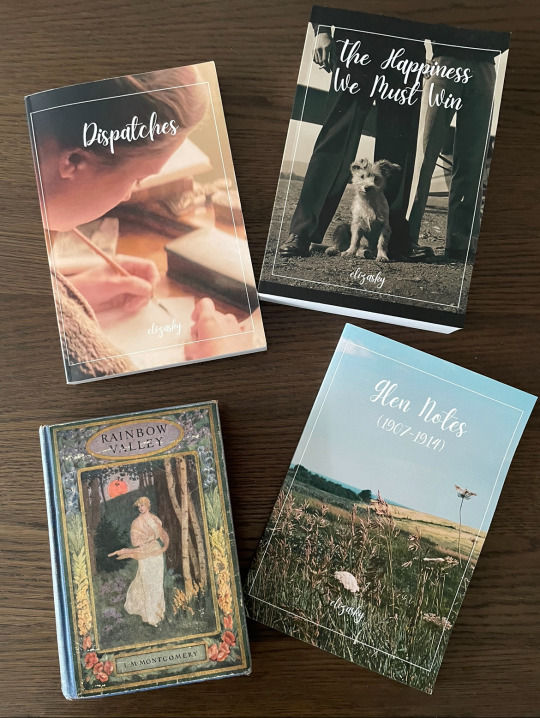
I made books from my favorite Rilla of Ingleside / Rainbow Valley fanfiction: the Glen Notes series by elizasky.
So now, on top of thinking about this story daily I can also just watch it sitting on my Lucy Maud Montgomery bookshelf, as one version of the continuity of canon, and I love it.

I used a picture I took in PEI for the first tome, and that makes it even more special to me.

This is the picture elizasky used as a cover for their story, they pointed me to their source so I found two others of the same set on the Library of Congress website. They were taken by Esther Bubley in 1943, so this could really be Shirley, Carl, and Muggins ❤️
4 notes
·
View notes
Text

And Rilla, I'm not afraid. When you hear the news, remember that.
Walter Blythe sits down to begin his last letter home.
From Rilla of Ingleside, by L.M. Montgomery.
141 notes
·
View notes
Text
✨Anne Blythe’s (Anne Shirley-Blythe’s namesake granddaughter) father is not Jem. It’s Shirley. It’s totally Shirley, you guys. It’s gotta be.✨
And like, Ieading right off by saying of course there’s no definitive answer to be had here, since Maud obviously isn’t available to confirm or refute any hypothesises, but I do big persist in suggesting that a very rational case can be presented for Shirley... one that at least outweighs what I now see as the generally baseless widely accepted assumption that Anne is Jem’s daughter. Keep in mind, I’m in no way trying to dog on this. The assumption is ready and easy to make, and I’d accepted fully this theory too, until about a week agooo.
ABOUT A WEEK AGO, I was poring over various Wikipedia entries for the Anne book series, and inevitably also ended up looking through the edit history of those pages. While sorting through the edit history (super extensive and interesting, by the way), the username ‘blefebvre’ popped into the archive, contributing a ton of information to the Anne pages overall, around 2008 and 2009 particularly. And literally, who else could this user be besides THE Benjamin Lefebvre? Brilliant Maud scholar and essayist, inexhaustible editor and publisher of ‘the Blythes are Quoted’? Welllll, one of these edits, a written family tree of Anne and Gilbert’s grandchildren, mentioned Anne Blythe... and pointedly noted that she was either the daughter of Jem or Shirley.
Reading that? Already a huge jump-scare surprise to me. This immediately challenged what I thought I knew about the third generation of Blythes. I sat straight up in bed, brain doing a nosedive, like wait wait wait wait wait… hold on, what? We don’t know for sure? We don’t know for sure?
Guys. We don’t know for sure.
Whichhhhh sent me on an immediate hunt to gather up what we do know for sure. The facts we do have. And it wasn’t a huge task, either… there’s really not a lot to collect.
But here it is:
In ‘the Blythes are Quoted’, Anne Blythe is mentioned in only one story, titled “The Road to Yesterday” (not to be confused with the TBAQ abridged predecessor book of the same title 😅).
All we really have of her is her name, and a couple of superficial second-hand anecdotes from a guy named Jerry (who is impersonating a fellow named Dick, but more on this a little later).
Her paternity is unconfirmed, but because her surname is Blythe (not Ford or Meredith), we can logically eliminate the possibility of her belonging to Nan, Di, or Rilla. Walter was, of course, lost in France. This leaves Jem and Shirley.
Tiny details about Anne.
As a matter of housekeeping, let me try to get the jump on any potential counter-arguments, and clear the air.
The only reason I’ve seen Jem credited with Anne is because…
1. Jem was married.
That’s the entire basis.
And I’ll grant you that. This is more than we got for Shirley. But let’s remember that at the end of ‘Rilla of Ingleside’, we only had a canon engagement between Jem and Faith... it takes getting around to ‘the Blythes are Quoted’ to absolutely conclude that their marriage went through. With the added extra bonus of finding out that they have children.
But even allowing that, ‘the Blythes are Quoted’ as an epilogue isn’t all inclusive. It isn’t a complete picture. It’s half a picture at the very best. Maud, pressured greatly, basically dumped all her disorganised, non-chronological and unedited Anne relevant WIPS + short stories + poems on her publisher's desk two days before she died. This is not a book that Maud put together, as a tailpiece collection. It was an assortment of partial works and in-character conversations that she’d tinkered with over decades. Works she never intended to see being published. They were vague ideas she was forming, little seeds. (It took a lot of effort from Benjamin Lefebvre to put TBAQ together in a readable way that made sense.)
Maud was over Anne. Over Anne by twenty years, at this point. So much so that noticeable character details and world building started slipping in Ingleside and Rilla… for obvious instance, in the lack of continuity around Shirley’s birth year, and the way readers saw almost no closure/representation for Shirley and Di, with varying degrees of near erasure in the original books.
But this doesn’t mean that Maud didn’t have plans for these two characters... their incomplete or unsatisfying stories certainly weren’t nefariously intended to be that way (there’s no secret meaning to the exclusion); Montgomery was just depleted and had been feeling ruinously dispassionate about the Blythes stories since ‘Anne of the Island’.
In ‘Reading Rilla’ we see in Maud’s many pages of left-out notes, that an ultimately scrapped journal entry from Rilla indicates that Diana Blythe wrote to their mother of her engagement to a foreign overseas officer. It’s unclear if this officer is the same ‘Austin boy’ that an older Glen woman in ‘the Blythes are Quoted’ privately wonders about (if Di 'really is engaged to him or not'), but this contradictory bit is probably just erroneous gossip from an unreliable narrator.
Anyway. All of this to say... that just because we don’t have a canon marriage for Shirley, it doesn’t disqualify him from having had a wife and kids in Maud’s post-war Four Winds. TBAQ stories were, to reiterate, half-pictures. Pictures that did/could drop a plot bomb in a single sentence. Looping back to Di, canonly we don’t have a marriage for her either... and yet, we do have two engagements that half-register. One engagement was definitive, reported by Di herself. The other a passing curiosity from someone not close enough to the Blythe family to know.
So... clearly, Maud had active intention, a plan, for Di and her own little happy epilogue. The same can be believed for Shirley. (I’m dying for the day the ‘Rainbow Valley’ and ‘Ingleside’ manuscripts get published, I’m convinced there’s more Shirley be found in the notes.)
Now, let’s dig in to Anne Blythe herself.
‘The Road to Yesterday’ is a short story about a woman named Susette (a spinster at 28), who is on the brink of an engagement to a wealthy man named Harvey Brooks. She expects the next day to be proposed to. On a whim and feeling nostalgic, she drives to Glen St. Mary, where she lived in her girlhood, for the evening. While there, she runs into a fellow, whom she believes to be Dick, her childhood bully who she hated profoundly. Except now, they’re grown and capable acting chummy over their shared memories. The weather takes a bad turn, and they take shelter and a meal together. Susette spends most of the time, all their ‘do you remembers’, being irritated by Dick’s constant name-dropping of the Blythes. He claims to have been kind of secret friends with Anne Blythe, which is contrary to Susette’s memory that Anne hated Dick. (In the end, it turns out that Susette was right… this isn’t Dick she’s talking to. It’s Jerry Thornton, Dick’s cousin.)
For the official record every Blythe mentioned in ‘the Road to Yesterday’ is as follows: Doctor Blythe, Mrs. Doctor Blythe, Rilla Ford, Jem Blythe [Jr.], Di Meredith [Jerry and Nan’s], and Anne Blythe.
It’s mostly a bunch of school yard talk, but the big takeaway for this purpose is that the Blythe/Meredith cousins all hung out together as school children.
Here’s some direct examples:
*****
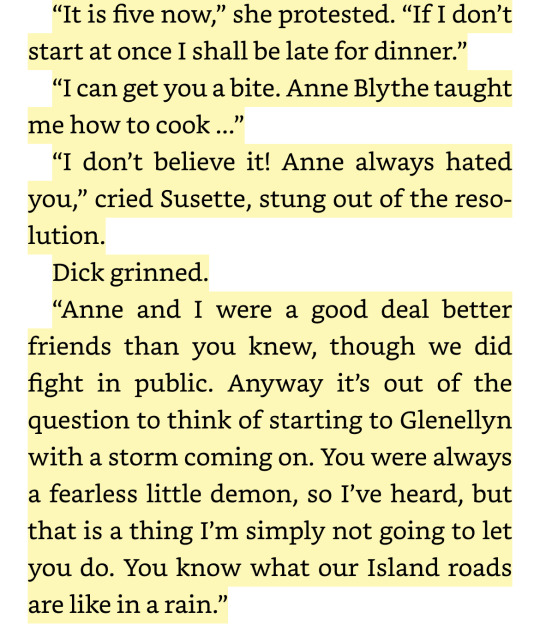
*****

*****
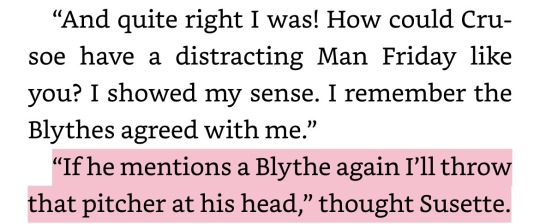
The cheap boiled-down version of this exchange, for those who haven’t ‘the Road to Yesterday’ is basically: Susette is having strange feelings during this interaction with ‘Dick’, she’s attracted to him, declaring to herself that she won’t fall in love with him, and is clearly irritated with the near constant Anne Blythe (especially)/Blythe references. Though she herself was very fond of Jem Blythe Jr. herself, during their childhood, ‘Dick’ mentioning Anne Blythe so fondly is increasingly Not Cute to Susette. Meanwhile, ‘Dick’ is enjoying this kind of teasing, and is lowkey successful at getting a rise out of Susette, not matter how determined she is to look unaffected.
But here’s the kicker... when ‘Dick’ finally leaves off mentioning Anne Blythe, guess what topic he moves on to? 🥁
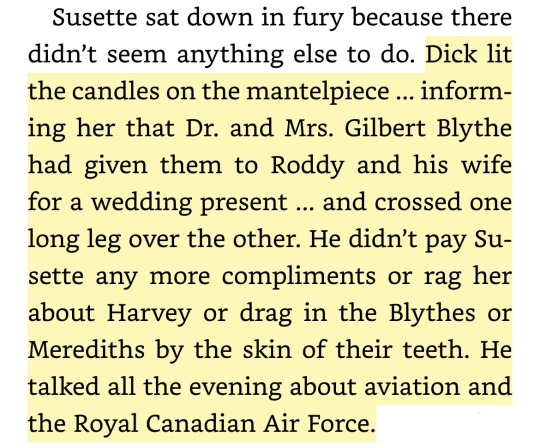
The Royal Canadian Air Force.
And just who do we all know that was in the Royal Canadian Air Force?
Shirley.
Only Shirley.
First, it tracks that ‘Dick,’ soon enlisting (we’re on the brink of WWII timeline-wise), and thinking himself funny, would choose to move on from Anne Blythe to instead a subtler rib… what he, as a once good pal of Anne’s, would know was Anne’s dad’s war faction. It’s also in the realm of possibilities that thinking on Anne so much drew up this correlation. I also ALSO think it’s worth mentioning that the only other time that the Canadian Air Force is mentioned in TBAQ is a very passing drop for Rilla, thinking of her son Gilbert Ford enlisting with the CAF. That’s it. Just those two times.
Additionally important to note is the overall subtext tone in TBAQ, which is Maud’s very greatest collection of double-vision, double-speak and intertextual reference works. There’s a beautiful scholarly essay on this, in relation to TBAQ particularly HERE.
This doesn’t only apply to cultural references in TBAQ. It also adds layers to Maud’s own existing Anne series. It really could be considered a companion piece, with X-Ray vision, e.g. how we got a ton of ‘missing’ insight into Anne and her children’s lives and minds, during the Rainbow Valley era, in Part 1 of TBAQ.
Part 2 of TBAQ (where we find ‘the Road to Yesterday’) asks us to apply what we already know to the new text we’re given.
So, understanding this … if we’re going off what we already know from ‘Rilla of Ingleside’…
What’s the reason we have the Canadian Air Force mentioned in the same story that we learn of the existence of Anne Blythe? The connection?
It’s Shirley. 🥹
A weaker argument that I’ll only mention in mild passing, because it is very weak in terms of convincing evidence, is that the text unambiguously tells is that Anne Blythe has taught ‘Dick’ from Susan’s famous recipes. Susan is another Shirley tie. It’s there to be stated. BUT. I do admit that I think Susan would’ve taught every willing Blythe grandchild with the same zeal, maybe some partiality given to the Little Brown Boy’s kid(s).
BUT, for me?
I’m properly convinced here.
Shirley was a dad, ya’ll.
80 notes
·
View notes
Text
Rereading the wonderful Eighteen Again by @scriibble-fics these days and my mind is constantly going back to Lily and James’ London.
I don’t know exactly which neighborhood scriibble had in my mind but James mentions Hampstead Heath ponds once and I love this area for this story. Where is Euphemia and Fleamont’s house? The Marauders’ flat? Lily’s muggle bookshop? Questions I like to think about….
I miss your stories scriibble!! Hope you’re okay.
Pics below borrowed to the beautiful theseptemberchronicles on Insta.



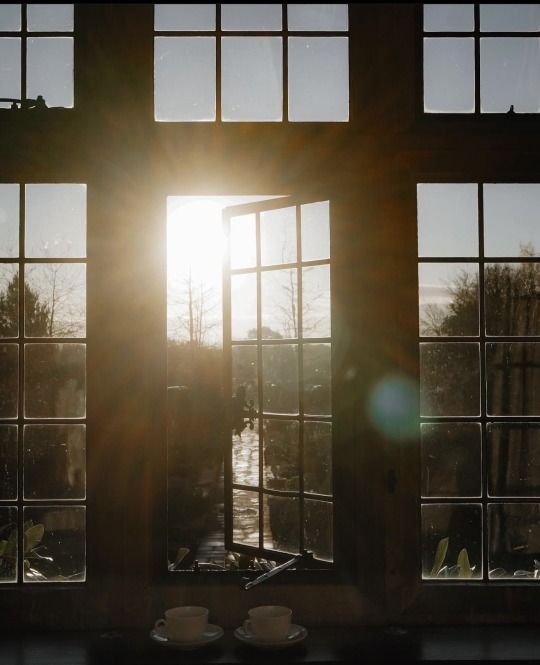
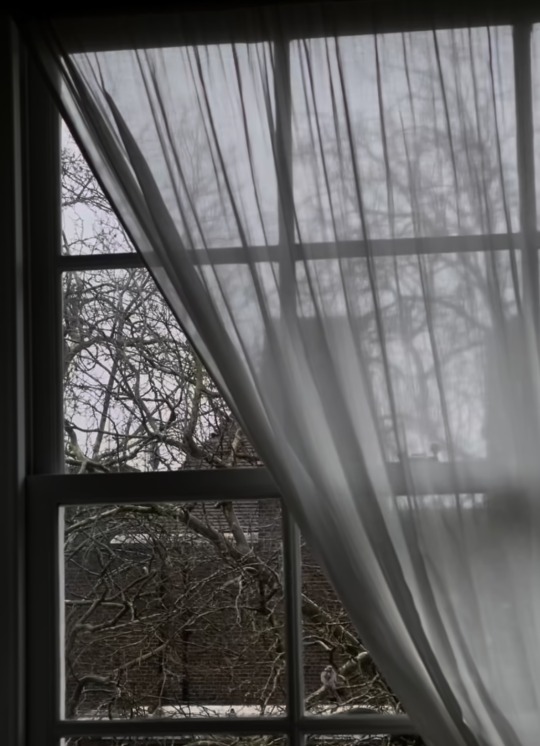

18 notes
·
View notes
Text
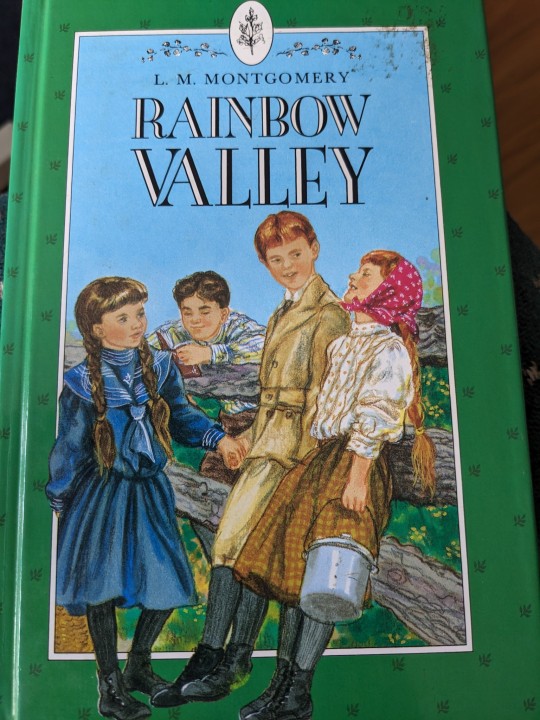
@shirleyjblythe recently had a post about a particular cover of Rainbow Valley and trying to determine who was depicted on it, so I thought I would share my copy, which is nice and simple - just the Merediths!
63 notes
·
View notes
